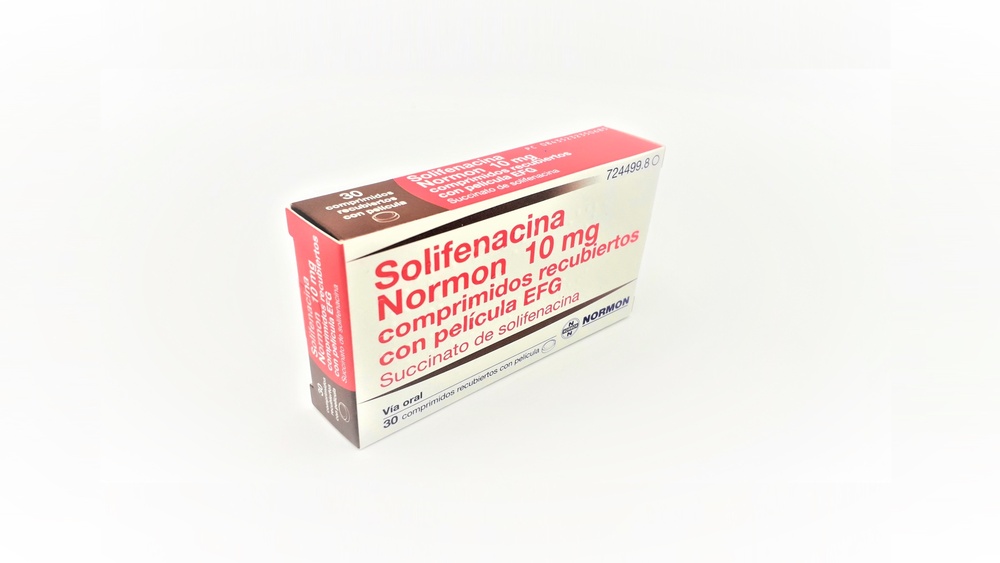

СОЛИФЕНАЦИН Ауровитас 10 мг ТАБЛЕТКИ, ПОКРЫТЫЕ ПЛЁНОЧНОЙ ОБОЛОЧКОЙ

Спросите врача о рецепте на СОЛИФЕНАЦИН Ауровитас 10 мг ТАБЛЕТКИ, ПОКРЫТЫЕ ПЛЁНОЧНОЙ ОБОЛОЧКОЙ

Инструкция по применению СОЛИФЕНАЦИН Ауровитас 10 мг ТАБЛЕТКИ, ПОКРЫТЫЕ ПЛЁНОЧНОЙ ОБОЛОЧКОЙ
Введение
Прошпект: Информация для пользователя
Солифенацин Ауровитас 10 мг, таблетки, покрытые пленкой ЕФГ
Сукцинат солифенацина
Прочитайте внимательно весь прошпект перед началом использования этого лекарства, поскольку он содержит важную информацию для вас.
- Сохраните этот прошпект, поскольку вам может потребоваться прочитать его снова.
- Если у вас есть какие-либо вопросы, проконсультируйтесь с вашим врачом или фармацевтом.
- Это лекарство было назначено только вам, и не передавайте его другим людям, даже если у них такие же симптомы, как у вас, поскольку оно может нанести им вред.
- Если вы испытываете побочные эффекты, проконсультируйтесь с вашим врачом, фармацевтом или медсестрой, даже если это побочные эффекты, которые не указаны в этом прошпекте. См. раздел 4.
Содержание прошпекта
- Что такое Солифенацин Ауровитас и для чего он используется
- Что вам нужно знать перед началом приема Солифенацина Ауровитас
- Как принимать Солифенацин Ауровитас
- Возможные побочные эффекты
- Хранение Солифенацина Ауровитас
- Содержание упаковки и дополнительная информация
1. Что такое Солифенацин Ауровитас и для чего он используется
Активное вещество Солифенацина Ауровитас относится к группе антихолинергических препаратов. Эти лекарства используются для снижения активности гиперактивной мочевого пузыря. Это позволяет вам иметь больше времени перед тем, как вам нужно будет пойти в туалет, и увеличивает количество мочи, которое ваш мочевой пузырь может удерживать. Солифенацин используется для лечения симптомов гиперактивного мочевого пузыря. Эти симптомы включают: сильную и внезапную необходимость мочиться без предупреждения, частое мочеиспускание или недержание мочи из-за того, что вы не успеваете добраться до туалета.
2. Что вам нужно знать перед началом приема Солифенацина Ауровитас
Не принимайтеСолифенацин Ауровитас
- Если вы аллергичны к солифенацину или к любому другому компоненту этого лекарства (указанному в разделе 6).
- Если у вас есть трудности с мочеиспусканием или с полным опорожнением мочевого пузыря (задержка мочи).
- Если у вас есть тяжелое расстройство желудка или кишечника (включая токсический мегаколон, осложнение, связанное с язвенным колитом).
- Если вы страдаете мышечной болезнью, называемой миастенией гравис, которая может вызвать чрезмерную слабость определенных мышц.
- Если у вас есть повышенное давление в глазах с постепенной потерей зрения (глаукома).
- Если вы проходите диализ почек.
- Если у вас есть тяжелое заболевание печени.
- Если у вас есть тяжелое заболевание почек или умеренное заболевание печени и одновременно вы принимаете лекарства, которые могут снижать выведение солифенацина из организма (например, кетоконазол). Ваш врач или фармацевт проинформирует вас, если это так.
Прежде чем начать лечение этим лекарством, сообщите вашему врачу, если у вас есть или были какие-либо из вышеуказанных заболеваний.
Предостережения и меры предосторожности
Проконсультируйтесь с вашим врачом или фармацевтом перед началом приема Солифенацина Ауровитас.
- Если у вас есть проблемы с опорожнением мочевого пузыря (= обструкция мочевого пузыря) или с мочеиспусканием (например, слабый поток мочи). Риск накопления мочи в мочевом пузыре (задержка мочи) намного выше.
- Если у вас есть какая-либо обструкция пищеварительной системы (запор).
- Если у вас есть риск снижения активности пищеварительной системы (движения желудка и кишечника). Ваш врач проинформирует вас, если это так.
- Если у вас есть тяжелое заболевание почек.
- Если у вас есть умеренное заболевание печени.
- Если у вас есть грыжа пищевода или изжога.
- Если у вас есть нервное расстройство (автономная нейропатия).
Дети и подростки
Солифенацин не должен использоваться у детей или подростков младше 18 лет.
Сообщите вашему врачу перед началом лечения солифенацином, если любая из вышеуказанных обстоятельств когда-либо发生ала с вами.
Прежде чем начать лечение солифенацином, ваш врач оценит, есть ли другие причины вашей частой необходимости мочиться (например, сердечная недостаточность или заболевание почек). Если у вас есть инфекция мочевыделительной системы, ваш врач назначит вам антибиотик (лечение против определенных бактериальных инфекций).
Прием Солифенацина Ауровитас с другими лекарствами
Сообщите вашему врачу, если вы принимаете, недавно принимали или можете принять любое другое лекарство.
Особенно важно сообщить вашему врачу, если вы принимаете:
- Другие антихолинергические лекарства, активность и побочные эффекты которых могут увеличиться.
- Холинергические лекарства, поскольку они могут снижать эффект солифенацина.
- Лекарства, такие как метоклопрамид или цисаприд, которые делают пищеварительную систему работать быстрее. Солифенацин может снижать их эффект.
- Лекарства, такие как кетоконазол, ритонавир, нельфинавир, итраконазол, верапамил и дилтиазем, которые снижают скорость выведения солифенацина из организма.
- Лекарства, такие как рифампицин, фенитоин и карбамазепин, поскольку они могут увеличивать скорость выведения солифенацина из организма.
- Лекарства, такие как бисфосфонаты, которые могут вызывать или ухудшать воспаление пищевода (эзофагит).
Прием Солифенацина Ауровитас с пищей, напитками и алкоголем
Солифенацин можно принимать с пищей или без нее, как вам больше нравится.
Беременность, лактация и фертильность
Не используйте солифенацин, если вы беременны, unless это абсолютно необходимо. Не используйте солифенацин во время лактации, поскольку солифенацин может проникать в грудное молоко.
Если вы беременны или в период лактации, считаете, что можете быть беременной или планируете стать беременной, проконсультируйтесь с вашим врачом или фармацевтом перед использованием этого лекарства.
Вождение и использование машин
Солифенацин может вызывать размытое зрение и иногда сонливость или усталость. Если вы испытываете любой из этих побочных эффектов, не驾айте транспортные средства и не используйте машины.
Солифенацин Ауровитас содержит лактозу
Это лекарство содержит лактозу. Если ваш врач указал, что у вас есть непереносимость определенных сахаров, проконсультируйтесь с ним перед приемом этого лекарства.
3. Как принимать Солифенацин Ауровитас
Следуйте точно инструкциям по применению этого лекарства, указанным вашим врачом или фармацевтом. В случае сомнений проконсультируйтесь с вашим врачом или фармацевтом.
Вы должны проглотить таблетку целиком с какой-либо жидкостью. Ее можно принимать с пищей или без нее, как вам больше нравится. Не разжевывайте таблетки.
Рекомендуемая доза составляет 5 мг в день, unless ваш врач указал, что вам нужно принимать 10 мг в день.
Если вы приняли больше Солифенацина Ауровитас, чем должно быть
В случае передозировки или случайного приема проконсультируйтесь с вашим врачом или фармацевтом или позвоните в Службу токсикологической информации, телефон: 91 562 04 20, указав лекарство и количество, принятое. Рекомендуется взять упаковку и прошпект лекарства к медицинскому специалисту. Симптомы при передозировке могут включать: головную боль, сухость во рту, головокружение, сонливость и размытое зрение, восприятие вещей, которых нет (галлюцинации), сильное возбуждение, судороги, трудности с дыханием, увеличение частоты сердечных сокращений (тахикардия), накопление мочи в мочевом пузыре (задержка мочи) и расширение зрачков (мидриаз).
Если вы пропустили прием Солифенацина Ауровитас
Если вы забыли принять дозу в обычное время, примите ее, как только вспомните, unless это время принятия следующей дозы.
Не принимайте двойную дозу, чтобы компенсировать пропущенные дозы. Если у вас есть какие-либо сомнения, всегда проконсультируйтесь с вашим врачом или фармацевтом.
Если вы прекратите лечение Солифенацином Ауровитас
Если вы перестанете принимать это лекарство, ваши симптомы гиперактивного мочевого пузыря могут вернуться или ухудшиться. Всегда проконсультируйтесь с вашим врачом, если вы думаете прекратить лечение.
Если у вас есть какие-либо другие вопросы о использовании этого лекарства, проконсультируйтесь с вашим врачом или фармацевтом.
4. Возможные побочные эффекты
Как и все лекарства, это лекарство может вызывать побочные эффекты, хотя не все люди испытывают их.
Если вы испытываете аллергическую реакцию или тяжелую кожную реакцию (например, образование пузырей и шелушение кожи), сообщите вашему врачу или фармацевту немедленно.
Было зарегистрировано ангиеодем (аллергия на коже, которая приводит к воспалению, происходящему в ткани под поверхностью кожи) с обструкцией дыхательных путей (трудностями с дыханием) у некоторых пациентов, леченных сукцинатом солифенацина (Солифенацин Ауровитас). Если появляется ангиеодем, необходимо немедленно прекратить лечение сукцинатом солифенацина (Солифенацин Ауровитас) и принять соответствующее лечение и/или меры.
Солифенацин может вызывать следующие побочные эффекты:
Очень частые(могут поражать более 1 из 10 человек)
- сухость во рту.
Частые(могут поражать до 1 из 10 человек)
- размытое зрение.
- запор, тошнота, диспепсия с симптомами, такими как чувство тяжести в желудке, боль в животе, отрыжка, тошнота и изжога, дискомфорт в желудке.
Нечастые(могут поражать до 1 из 100 человек)
- инфекция мочевыделительной системы, инфекция мочевого пузыря.
- сонливость.
- анормальное восприятие вкуса (дисгевзия).
- сухость глаз (ирритация).
- сухость носовых проходов.
- рефлюксное заболевание (гastroэзофагеальная рефлюксная болезнь), сухость горла.
- сухость кожи.
- трудности с мочеиспусканием.
- усталость.
- накопление жидкости в нижних конечностях (отек).
Редкие(могут поражать до 1 из 1000 человек)
- накопление большого количества каловых масс в толстой кишке (фекальная импакция).
- накопление мочи в мочевом пузыре из-за невозможности опорожнить мочевой пузырь (задержка мочи).
- головокружение, головная боль.
- рвота.
- зуд, кожная сыпь.
Очень редкие(могут поражать до 1 из 10 000 человек)
- галлюцинации, конфузия.
- аллергическая кожная сыпь.
Частота не известна(частота не может быть оценена из доступных данных)
- снижение аппетита, высокие уровни калия в крови, которые могут вызывать аномальный сердечный ритм.
- увеличение давления в глазах.
- изменения электрической активности сердца (ЭКГ), нерегулярные сердечные сокращения, сердцебиение, быстрое сердцебиение.
- расстройство голоса.
- расстройство печени.
- слабость мышц.
- расстройство почек.
Сообщение о побочных эффектах
Если вы испытываете любой побочный эффект, проконсультируйтесь с вашим врачом или фармацевтом, даже если это возможные побочные эффекты, которые не указаны в этом прошпекте. Вы также можете сообщить о них напрямую через Систему фармаковигиланса лекарственных средств для человека: www.notificaram.es. Сообщая о побочных эффектах, вы можете внести свой вклад в предоставление более полной информации о безопасности этого лекарства.
5. Хранение Солифенацина Ауровитас
Храните это лекарство вне поля зрения и досягаемости детей.
Не используйте это лекарство после даты истечения срока годности, указанной на упаковке после CAD. Дата истечения срока годности - последний день месяца, указанного.
Не требует специальных условий хранения.
Лекарства не должны выбрасываться в канализацию или в мусор. Поместите упаковку и лекарства, которые вам больше не нужны, в пункт SIGRE аптеки. В случае сомнений проконсультируйтесь с вашим фармацевтом, как избавиться от упаковки и лекарств, которые вам больше не нужны. Таким образом, вы поможете защитить окружающую среду.
6. Содержание упаковки и дополнительная информация
Состав Солифенацина Ауровитас
- Активное вещество - сукцинат солифенацина. Каждая таблетка, покрытая пленкой, содержит 10 мг сукцината солифенацина.
- Другие компоненты:
Ядро таблетки:лактоза моногидрат, кукурузный крахмал, гипромелоза (5 сп), коллоидный силиций безводный, стеарат магния.
Покрытие таблетки:гипромелоза (6 сп), макрогол (ПЭГ 4000), диоксид титана (Е171), тальк, оксид железа красный (Е172).
Внешний вид продукта и содержание упаковки
Таблетки, покрытые пленкой, круглые (7,6 мм в диаметре), светло-розового цвета, двояковыпуклые, с маркировкой "CC" на одной стороне и "32" на другой.
Солифенацин Ауровитас таблетки, покрытые пленкой, выпускаются в блистерных упаковках из прозрачного ПВХ и алюминия по 30 таблеток, покрытых пленкой.
Владелец разрешения на маркетинг и ответственный за производство
Владелец разрешения на маркетинг:
Ауровитас Испания, С.А.У.
Авенида де Бургос, 16-Д
28036 Мадрид
Испания
Телефон: 91 630 86 45
Факс: 91 630 26 64
Ответственный за производство:
АПЛ Свифт Сервисес (Мальта) Лимитед
ХФ26, Хал Фар Индастриал Эстейт, Хал Фар
Бирзеббуджа, ББГ 3000
Мальта
Это лекарство разрешено в государствах-членах ЕЭС под следующими названиями:
Испания: | Солифенацин Ауровитас 10 мг таблетки, покрытые пленкой ЕФГ |
Италия: | Солифенацин Ауробиндо |
Португалия: | Солифенацин Глоб |
Дата последнего пересмотра этого прошпекта: Февраль 2016
Подробная информация о этом лекарстве доступна на сайте Агентства по лекарственным средствам и медицинским изделиям Испании (АЕМПС) (http://www.aemps.gob.es/).

Сколько стоит СОЛИФЕНАЦИН Ауровитас 10 мг ТАБЛЕТКИ, ПОКРЫТЫЕ ПЛЁНОЧНОЙ ОБОЛОЧКОЙ в Испании в 2025 году?
Средняя цена на СОЛИФЕНАЦИН Ауровитас 10 мг ТАБЛЕТКИ, ПОКРЫТЫЕ ПЛЁНОЧНОЙ ОБОЛОЧКОЙ в декабрь, 2025 года составляет около 40.81 евро. Финальная стоимость может зависеть от региона, конкретной аптеки и рецептурного статуса. Для точной информации лучше проверить онлайн или в ближайшей аптеке.
- Страна регистрации
- Средняя цена в аптеках40.81 EUR
- Активное вещество
- Требуется рецептДа
- Производитель
- Информация носит справочный характер и не является медицинской рекомендацией. Перед приемом любых препаратов проконсультируйтесь с врачом. Oladoctor не несет ответственности за медицинские решения, принятые на основе этого контента.
- Аналоги СОЛИФЕНАЦИН Ауровитас 10 мг ТАБЛЕТКИ, ПОКРЫТЫЕ ПЛЁНОЧНОЙ ОБОЛОЧКОЙФорма выпуска: ТАБЛЕТКА, 10 мгАктивное вещество: солифенацинПроизводитель: Laboratorios Alter S.A.Требуется рецептФорма выпуска: ТАБЛЕТКА, 5 мгАктивное вещество: солифенацинПроизводитель: Laboratorios Alter S.A.Требуется рецептФорма выпуска: ТАБЛЕТКА, 10 мгАктивное вещество: солифенацинПроизводитель: Laboratorios Q Pharma S.L.Требуется рецепт
Аналоги СОЛИФЕНАЦИН Ауровитас 10 мг ТАБЛЕТКИ, ПОКРЫТЫЕ ПЛЁНОЧНОЙ ОБОЛОЧКОЙ в других странах
Лучшие аналоги с тем же действующим веществом и терапевтическим эффектом.
Аналог СОЛИФЕНАЦИН Ауровитас 10 мг ТАБЛЕТКИ, ПОКРЫТЫЕ ПЛЁНОЧНОЙ ОБОЛОЧКОЙ в Polska
Аналог СОЛИФЕНАЦИН Ауровитас 10 мг ТАБЛЕТКИ, ПОКРЫТЫЕ ПЛЁНОЧНОЙ ОБОЛОЧКОЙ в Ukraina
Врачи онлайн по СОЛИФЕНАЦИН Ауровитас 10 мг ТАБЛЕТКИ, ПОКРЫТЫЕ ПЛЁНОЧНОЙ ОБОЛОЧКОЙ
Консультация по дозировке, побочным эффектам, взаимодействиям, противопоказаниям и продлению рецепта на СОЛИФЕНАЦИН Ауровитас 10 мг ТАБЛЕТКИ, ПОКРЫТЫЕ ПЛЁНОЧНОЙ ОБОЛОЧКОЙ – по решению врача и с учетом местных правил.






